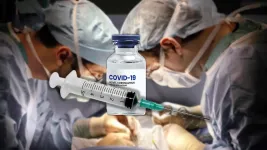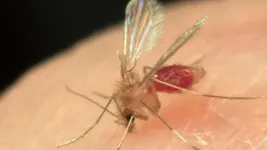(Press-News.org) ITHACA, N.Y. - By swiping surfaces in commercial food processing plants with specially designed rapid-testing adenosine triphospate (ATP) swabs - which produce a light similar to the glow of fireflies in the presence of microorganisms - spoilage and foodborne illness could diminish, according to a new study from Cornell University food scientists.
During food production, routine cleaning and surface sanitation are keys to help prevent microbial contamination in the end food products. Without such a sanitation regime, food from processing plants can become more vulnerable to spoilage, and people who eat that food may face greater risk with illness or death from foodborne pathogens.
"Food scientists know that for processing plants, visual inspection is not a reliable indicator of cleaning-protocol success," said Randy Worobo, professor of food science in the College of Agriculture and Life Sciences (CALS) and faculty fellow at the Cornell Atkinson Center for Sustainability. "All food factory 'ecosystems' are prone to niches where microorganisms can hang out or where food residues can persist. We need to find them."
Worobo is senior author of the study, "Implementation of ATP and Microbial Indicator Testing for Hygiene Monitoring in a Tofu Production Facility Improves Product Quality and Hygienic Conditions of Food Contact Surfaces: A Case Study," which published on Feb. 12 in Applied and Environmental Microbiology.
Each year more than 48 million Americans get sick from foodborne pathogens; more than 120,000 are hospitalized and about 3,000 die, according to the U.S. Centers for Disease Control and Prevention.
Examining the efficacy of an environmental monitoring program using the 3M Clean-Trace Hygiene Monitoring and Management system for ATP monitoring, in combination with 3M Petrifilm Plates, for microbiological enumeration - Worobo and lead author Jonathan H. Sogin, a doctoral student in food science, in partnership with 3M Food Safety microbiologists, spent nine months testing samples collected from the processing environment in a commercial tofu manufacturing facility.
Worobo, Sogin and the 3M Food Safety team assembled a custom-designed plan to use an ATP swab test to check dozens of critical points in the plant after it had been cleaned. Following use, the ATP swab is placed in a luminometer instrument, where the bioluminescence of contaminants is detected.
The amount of light is transformed in the luminometer to relative light units, where this value is displayed on the instrument. If it exceeds a defined threshold value, the surface would be considered dirty and may indicate that cleaning operations were not performed properly.
Results show that targeted cleaning - demonstrated by ATP monitoring, and verified by further microbiological tests - can improve the environmental hygiene of food-processing facilities.
"If a plant supervisor is responsible for the cleaning crew and the supervisor says, 'That's not clean enough,' there might be an employee who thinks that the supervisor is picking on them," Worobo said. "Instead, if you have luminometer, like the 3M Clean-Trace system, that device removes the bias so that the cleaning crew itself can see the numbers. These methods become a quantitative way to ensure that they're doing a good job."
ATP monitoring and microbiological enumeration can verify and improve the efficacy of cleaning and sanitation practices, which can have a positive impact not only for the facility, but for product quality, Sogin said.
"This test can not only verify that the plant's equipment and food-contact surfaces are cleaned and sanitized before starting food preparations, it can identify problematic situations. It helps you become a sleuth," Worobo said. "But as a standard, the industry should be using this method to verify cleaning and sanitation programs. It's key."
INFORMATION:
In addition to Worobo and Sogin, contributors included Maro C?obo, technician, Cornell AgriTech; and technical applications specialists Cari Lingle and Gabriela Lopez-Velasco, technical sales manager Burcu Yordem, and global scientific affairs manager John M. David, all of 3M.
This study was supported by a 3M-sponsored research contract, with additional funding by the U.S. Department of Agriculture and the College of Agriculture and Life Sciences.
PHILADELPHIA-- When evaluating the opioid crisis, research reveals that external factors - such as the volume of pre-filled syringes, or a default number of opioid tablets that could easily be ordered at discharge for the patient - can shift prescribing and compel emergency department (ED) physicians to administer or prescribe greater quantities of opioids. A new study published in the Journal of Medical Toxicology reveals that opioid prescribing behavior can also be decreased by external factors, such as a supply shortage.
Led by the Perelman School of Medicine at the University of Pennsylvania, researchers evaluated pharmacy data from the electronic medical records (EMR) collected before, during, and after a period of parenteral ...
BOSTON - New research led by a team at Massachusetts General Hospital (MGH) points to a promising strategy to boost tumors' intake of cancer drugs, thereby increasing the effectiveness of chemotherapy treatments. The group's findings are published in Nature Nanotechnology.
Getting enough anticancer drugs into a tumor is often difficult, and a potential strategy to overcome this challenge involves binding the medications to albumin, the most abundant protein in blood. The strategy relies on tumors' large appetite for protein nutrients that fuel malignant growth. When consuming available albumin, the tumors will inadvertently take in the attached drugs.
A popular albumin-bound drug approved by the U.S. Food and Drug Administration is ...
How did people living in the Bronze Age manage their finances before money became widespread? Researchers from the Universities of Göttingen and Rome have discovered that bronze scrap found in hoards in Europe circulated as a currency. These pieces of scrap - which might include swords, axes, and jewellery broken into pieces - were used as cash in the late Bronze Age (1350-800 BC), and in fact complied with a weight system used across Europe. This research suggests that something very similar to our 'global market' evolved across Western Eurasia from the everyday use of scrap for cash by ordinary people some 1000 years before the beginning of classical civilizations. The results were published in Journal of Archaeological Science.
This study analysed around ...
'Natural disasters,' sparked by climate change and other natural hazards, increase the triggers for violence against women and girls by boosting the means, opportunity, and underlying drivers, finds a review of the available evidence, published in the online journal BMJ Global Health.
As these disasters are increasing in frequency, severity, and duration worldwide, this consequence must now be formally recognised in public health, violence prevention, and disaster management strategies, urge the researchers.
Over the past two decades, 7348 ...
New research from Simon Fraser University suggests that students learning remotely become night owls but do not sleep more despite the time saved commuting, working or attending social events.
The study, led by psychology professor Ralph Mistlberger, Andrea Smit and Myriam Juda, at SFU's Circadian Rhythms and Sleep Lab, compared self-reported data on sleep habits from 80 students enrolled in a 2020 summer session course at SFU with data collected from 450 students enrolled in the same course during previous summer semesters. The study results were recently published in the journal PLOS ONE.
"There is a widespread belief among ...
In a study published today in the Journal of the American Medical Association (JAMA), Johns Hopkins Medicine researchers show that although two doses of a vaccine against SARS-CoV-2 -- the virus that causes COVID 19 -- confers some protection for people who have received solid organ transplants, it's still not enough to enable them to dispense with masks, physical distancing and other safety measures.
This is a follow-up study to an earlier one published in March in JAMA, in which the researchers reported that only 17% of the participating transplant recipients produced sufficient antibodies after just one dose of a two-dose COVID-19 vaccine regimen.
"While there was an ...
Loneliness and social isolation have been significant problems for the general population during the COVID-19 pandemic, but for cancer patients these issues were particularly acute, likely due to isolation and social distancing, according to a new UCSF study.
The study, which is the first to evaluate loneliness, anxiety, depression, fatigue and other symptoms in a single group of patients, is published in Cancer, a peer-reviewed journal of the American Cancer Society.
"We found that oncology patients were experiencing a deep sense of loneliness," ...
Researchers at North Carolina State University and the University of North Carolina Greensboro made a surprising finding while examining areas where sand flies rear their young: a new species of bacteria that is highly attractive to pregnant, or gravid, sand flies. The findings could advance the production of ecologically safe baits or traps to reduce sand fly populations.
Sand flies are vectors for important parasitic diseases affecting people in tropical and subtropical regions in Asia, Africa and the Middle East. One of those diseases is Leishmaniasis, which generally causes ...
HOUSTON - (May 6, 2021) - A Rice University laboratory has adapted its laser-induced graphene technique to make high-resolution, micron-scale patterns of the conductive material for consumer electronics and other applications.
Laser-induced graphene (LIG), introduced in 2014 by Rice chemist James Tour, involves burning away everything that isn't carbon from polymers or other materials, leaving the carbon atoms to reconfigure themselves into films of characteristic hexagonal graphene.
The process employs a commercial laser that "writes" graphene patterns into surfaces that to date have included wood, paper and even food.
The new iteration writes fine patterns of graphene into photoresist polymers, light-sensitive materials used in photolithography and ...
As the human body's largest organ, the skin is responsible for protecting against a wide range of possible infections on all fleshy surfaces, from head to toe. So how exactly does the skin organize its defenses against such an array of threats?
A new Yale study shows that the epidermis, the outermost layer of skin, is comprised of an army of immune cells that station themselves at regular intervals across the skin's vast expanse to resist infection. When necessary, the researchers found, these immune system soldiers are able to reposition themselves to protect vulnerable areas.
The study, published in the journal Nature Cell Biology, was conducted by the lab of Valentina ...



